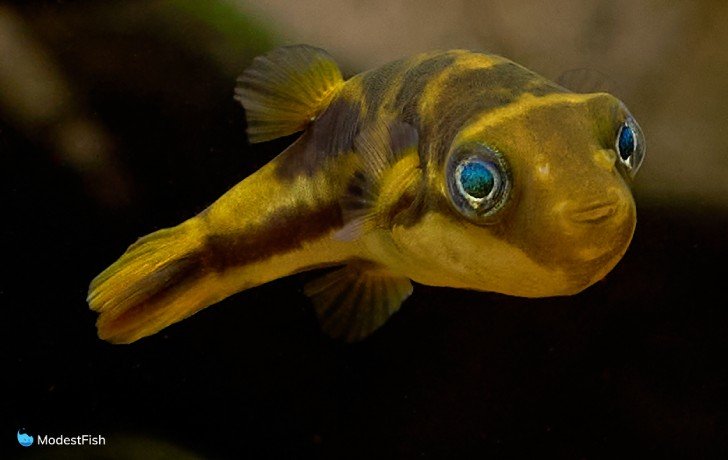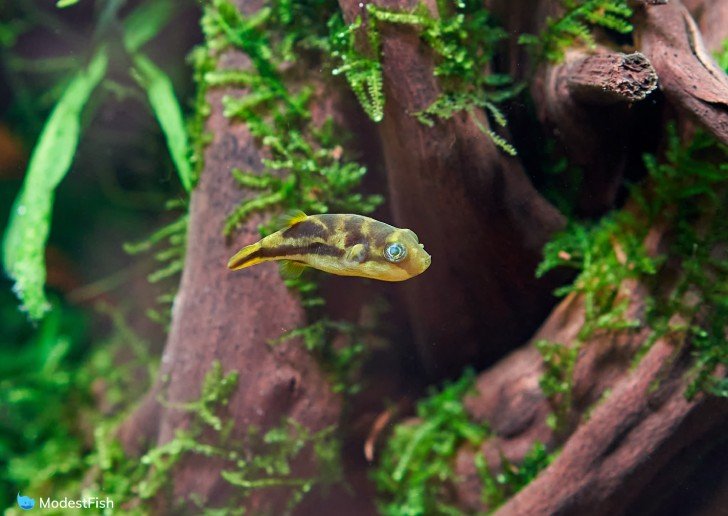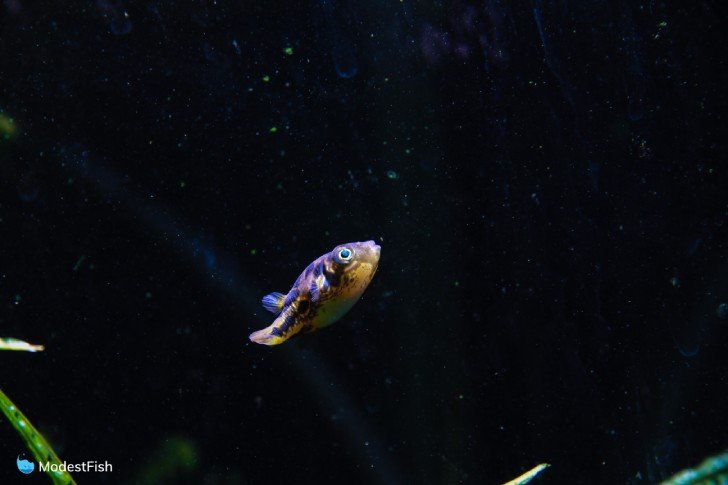There’s something about pea puffers (Carinotetraodon travancoricus). They’re a tiny, special little fish with a whole lot of attitude.
A fish I believe to be a tad too delicate for a novice fish keeper, I’ll lay out everything you need to know in order to provide the best care for pea puffers.
Care Overview
Pea Puffer (Carinotetraodon travancoricus)
Key Characteristics
- Size: 1 inches (2.5cm)
- Life span: 4-5 years
- Temperament: Shoaling fish, males can be quite aggressive and territorial
- Tank Mates: Generally best in species only tank
- Living Zone: All over
- Diet: carnivore
Water Parameters
- Temperature: 74°-82°F (23°-28°C)
- Ammonia: 0ppm
- Nitrite: 0 ppm
- Nitrate: <20 ppm
- pH: 7.0-7.5
- GH: 3-20 dGH
- KH: 3-10 dKH
Care Schedule
- Daily: feeding 1-2 small meals
- Weekly: Water test. If nitrates are high, do 20-25% water change
- Monthly: Plant trimming, equipment check
Scientific Classification
- Kingdom: Animalia
- Phylum: Chordata
- Class: Actinopterygii (ray-finned fishes)
- Order: Tetraodontiformes
- Family: Tetraodontidae (Pufferfish)
- Genus: Carinotetraodon
- Species: Carinotetraodon travancoricus

Tank Setup Overview
Tank Supplies
5 Gallons (per fish)
Sponge Filter
Heater
LED Lighting
Thermometer
Live Plants
Inert Substrate
Decorations
Water Conditioner
5 gallon bucket
API Master Test Kit
Algae scraper
Gravel vacuum
Aquascape Scissors
Diet
Brine shrimp
Bloodworms
Tubifex Worms
California black worms
Daphnia
Mysis shrimp
Small snails
Table of Contents
Pea Puffer Species Profile Introduction

Pea puffers originate from freshwater rivers in central India. They shoal together in huge groups. These shoals move up and down the riverbank, eating copepods, small snails, crustaceans, insects and larvae.
Sadly, these little fish have been given the status of “vulnerable’’ in the wild. Their numbers have dwindled in recent years because of habitat loss and overfishing.
If at all possible, please purchase puffers that were tank bred. If you do buy a wild caught puffer, it’s recommended to thoroughly deworm them.
This species is a little hard to describe, but I’ll give it my best shot.
They have huge eyes compared to their body size. It gives them a really cute, inquisitive expression.
Pea puffers have a pointed snout that is tipped with a tiny beak made of hard keratin that they use to chew up snails.
Well fed adults have a rounded body that quickly tapers towards the rear of the body. Their caudal fin (tail) is sometimes folded, making it look like the fish doesn’t even have a tail.
Most are a dusky gold color with irregular spots and splotches of dark brown.
Like other freshwater puffers, they swim mostly by using their two pectoral fins, making it look like they hover in the water like a bumblebee hovering over the garden.
Mature males have iridescent markings behind their eyes, often called “wrinkles” and most have a black stripe or spot on their bellies. They are also usually a brighter yellow than the females when they are fully mature. Females have a rounder body shape and have a pale belly with no spots or stripes.
Pea puffers are also known as Dwarf Pufferfish, Pea Puffer Fish, Pygmy Pufferfish, Dwarf Pea Puffer and the Malabar Pufferfish.
These fish are generally sold as juveniles. Unfortunately, you will not be able to accurately sex them until they are almost fully mature.
Pea Puffer Tank & Equipment Requirements

- 5 gallons of water per puffer fish
- Inert substrate
- Sponge Filter
- LED lighting
- Heater
- Thermometer
- Live plants
- Decorations
Tank Size
Pea puffers are rather small fish. So there’s no need to buy a huge tank in order to keep this species.
You can keep a single pea puffer in a 5 gallon (19 liter) tank (bigger is always better, though!).
If you want to have multiple puffers, it’s best to provide 5 gallons per fish. So, a pair should go in a 10 gallon (39 liter), three should go in a 15 gallon (57 liter), and so on.
Filtration
Having good filtration is essential to any aquarium.
Filters pump water around the tank and keep it from becoming stagnant. But, they actually do so much more than that.
There are beneficial bacteria that grow inside of aquarium filters that help to detoxify waste byproducts in the water.
Heater
Pea puffers require temperatures of 74°-82°F (23°-28°C), much higher than normal room temperature.
A heater is absolutely necessary for this species. You can read here about different heaters we’ve tested for safety and reliability.
Substrate
Pea puffers do best in a heavily planted tank, so you might want to use some sort of plant substrate to help you grow lots of rooted plants.
A substrate from Seachem, Fluval, or ADA aqua soil would be my recommendations.
Research planted substrates before you add them to your tank. Many can alter water chemistry, lowering pH or even leaching ammonia. Some also have to be replaced every few years.
Lighting
You have to strike a bit of a balance when it comes to lighting a pea puffer tank. Puffers do better with diffuse light. Bright lights suddenly snapping on can startle them and cause stress.
But, you want good, strong lighting in order to grow live plants in the tank.
I think the best way to do both is to add some floating plants that break up the light, creating a more dappled effect.
Also, if you have the kind of lights that can be programmed to come on slowly, instead of all at once, a dawn cycle or “ramp up” period can save the fish some stress.
If you don’t have a programmable light, you can try turning on a bright light in the room a few minutes before turning on the tank light.
Plants and Decor

Live plants are the most important thing to a pea puffer aquarium. These fish prefer a heavily planted tank. They will feel happier and more secure living in a tiny jungle.
This is especially true if you plan on keeping more than one puffer. Densely planted tanks will give everyone areas where they can retreat and avoid aggressive neighbors.
It’s best to have lots of plants rooted in the substrate that grow to the top of the tank. Your pea puffers will happily hover around the stems, looking for food. Crypts, anubias, java moss, swords, java ferns are all great options.
It’s also a good idea to add floating plants that will shade the tank and reduce the harsh glare from bright lights.
Water Parameters
Tank bred pea puffers are able to adapt to a wider range of water conditions.
- Temperature: 74°-82°F (23°-28°C)
- Ammonia: 0ppm
- Nitrite: 0 ppm
- Nitrate: <20 ppm
- pH: 7.0-7.5
- GH: 3-20 dGH
- KH: 3-10 dKH
In order to achieve stable water parameters, you must ensure you’re introducing your pea puffers into an established cycled tank. You see, fish constantly put waste into the water. These wastes accumulate in the substrate and start to rot.
As the wastes break down, they start to put off deadly ammonia (NH3) into the water. This is really bad news because it only takes one part per million of ammonia to stress and even kill many species of fish.
Luckily, the bacteria in a fish filter eat up the ammonia and turn it into nitrite (NO2 -1) and then into something called nitrate (NO3-).
Nitrate is much less toxic and can be allowed to build up in the water column in between weekly water changes.
Without a filter, wastes will build and build in the tank until the water is completely toxic. Good filtration is critical to successful fish keeping, so plan on adding a filter to your tank.
There is a process to getting the right amount of beneficial bacteria to grow in your filter. For more information on the Aquarium Nitrogen Cycle, please see this more in depth article.
Feeding

When it comes to food, pea puffers can be very picky eaters. These fish are strictly carnivorous and usually will only accept live or frozen foods.
Live and frozen foods include:
- California black worms
- Bloodworms
- Daphnia
- Adult brine shrimp
- Mysis shrimp
- Small snails
Pro Tip: Fish keepers have strongly noted that this species will not accept dry foods like pellets or flakes. Be prepared to provide live or frozen foods exclusively.
Maintenance Schedule
Maintenance equipment:
- Algae scraper
- API Master Test Kit
- Water Conditioner
- Gravel vacuum
- 5 gallon bucket
- Aquascape scissors
Daily tasks would include feeding and observing the overall well being of your tank.
Weekly you’ll need to test the water (I recommend API Master Test kit). And test for ammonia, nitrite, nitrate, pH, and hardness. If nitrates are starting to creep to high, you can perform a 20-25% water change. You can also clear away any unwanted algae build up and check equipment is functioning properly.
Monthly tasks can be trimming back any plants. This is all about personal preference though. Check on equipment functionality.
Pea Puffer Behavior & Tank Mates
Finding tank mates for pea puffers can be quite difficult.
These fish look little and cute, but are quite notorious for biting their tank mates. They may not be able to swallow a tank mate whole, but their little beaks are very sharp and capable of taking a chunk out of much larger fish.
It’s also easy for larger fish to swallow the tiny puffer fish whole.
Honestly, it’s best to keep these little maniacs in a species only tank. The one exception that I have heard about is Otocinclus catfish. It’s been reported that the puffers will simply ignore the oto cats.
If your tank is large enough, and very heavily planted, you can keep several pea puffers together. They will need around 5 gallons per fish so they can set up their own little territories.
You would need a 10 gallon (39 liter) for a pair, a 15 gallon (57 liter) for three puffers, and so on.
This species will devour snails and likely smaller shrimp, like cherries or crystal shrimp. They don’t have to be able to swallow something whole, they can just take little bites out of a snail or shrimp until it dies.
Breeding Pea Puffers
Doesn’t take too much to breed pea puffers. Here’s what you need to know.
Sexing Pea Puffers
Males have a sleeker body shape than females. Once they are mature, most will have a dark stripe that runs from their chin to their anus.
Males also have tiny iridescent blue markings behind their eyes that look like tiny cracks or wrinkles. Males also tend to be a brighter yellow color.
Females will have a pale or even white belly that has no stripes or spots. They also have a rounder body shape and no blue markings behind their eyes.
The big problem with sexing pea puffers is that they do not show these distinctive characteristics until they are almost fully mature.
Pea puffers are generally sold as juveniles but they all pretty much look like females at that point.
You may have to buy a group of puffers, let them mature and then shuffle around fish until you have the correct proportions of 1 male to every 2-3 females.
Breeding Tank
You will need to set up a dedicated breeding tank for these fish because the adults will need to be separated from the fry.
It’s best to mimic the conditions of the main tank in your breeding tank so that fish can be transferred without much fuss.
It’s been noted that pea puffers don’t need much inducement in order to spawn. As long as you have males and females together, and they’re happy and healthy, they will most likely spawn on their own.
The adults will lay eggs in quiet areas of the tank. They will often lay the eggs on rocks, decor or plants toward the back of the tank.
Once the eggs are laid, move the adults to another tank. The eggs will hatch in 24-48 hours and the fry will become free swimming within a week of being laid.
It’s best to feed the babies a commercially prepared liquid fry food until they are large enough to eat baby brine shrimp.
Is a Pea Puffer Right for You?
There’s no denying it, there’s just something special about these tiny fish. Despite their small size, they’ve got huge personalities and a lot of attitude.
Pea puffers don’t require a huge tank so you don’t have to break into your 401(k) to get going with them.
I would strongly recommend creating a species only tank for these guys. You can try to pair them with otocinclus catfish, but be prepared to move the otos if the puffers start to get nippy.
But, give up any dreams of having puffer fish in your community tank. These guys do not play well with others.
I think this species is a great fish for someone who already has some experience keeping fish. I think pea puffers may be a little too delicate for novice fishkeepers.
But, I also think that these little guys can really bring a lot of joy to a seasoned aquarist, and if you’re willing to dedicate a tank to them, I think keeping them will be a great experience overall.
I hope you find this information helpful.
I wish you and your fish the very best!

Thank you so much for this write up on dwarf puffers! I have a 10 gallon I was going to use for African dwarf clawed clawed frogs but I got them their own 55 gallon. I have several other large aquariums that have been going for about 5 years, so I kinda know what I am doing lol Your article helped me SO VERY MUCH as I begin my journey with these adorable little guys! Ty again!!!